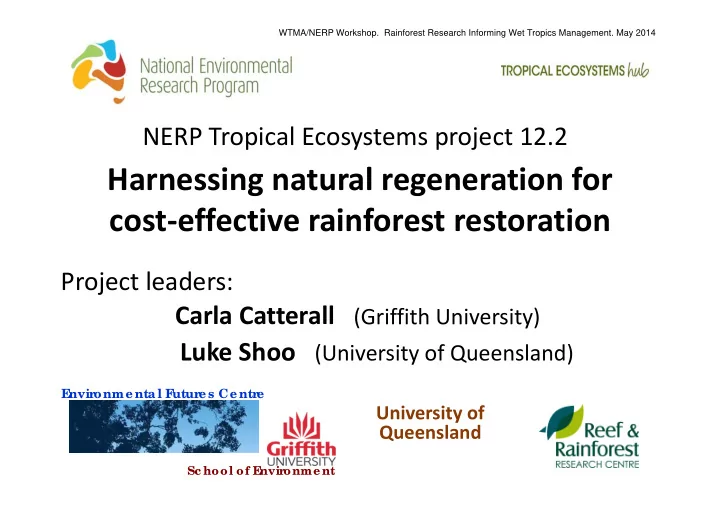

WTMA/NERP Workshop. Rainforest Research Informing Wet Tropics Management. May 2014 NERP Tropical Ecosystems project 12.2 Harnessing natural regeneration for cost ‐ effective rainforest restoration Project leaders: Carla Catterall (Griffith University) Luke Shoo (University of Queensland) E nvir onme ntal F utur e s Ce ntr e University of Queensland Sc hool of E nvir onme nt
Harnessing natural regeneration for cost-effective rainforest restoration Replanted sites Regrowth Pasture Rainforest
Can revegetation rescue declining rainforest biodiversity ? – in the face of fragmentation and climate change Rainforest reforestation pathways: Ecological restoration: • planted for environmental reasons; • many tree species; high density, mostly natives. & HIGH COST Autogenic regrowth • establishes without assistance; • trees native or exotic, variable diversity/density. & LOW COST need info on - rates of development in active restoration vs passive regrowth - how these are affected by landscape context decision-support systems for targeting different actions
NERP Tropical Ecosystems Project 12.2 Harnessing natural regeneration for cost-effective rainforest restoration This project’s core question : What is the potential of naturally-regenerating rainforest (regrowth) for low-cost restoration of critical habitat over large areas, and how does this compare with replanting?
Builds on previous work: 1. Rainforest CRC 1999-2006: “Biodiversity values of rehabilitation & restoration” - inventory of reforestation activities - biodiversity outcomes of different reforestation pathways [ plants, structure, birds, reptiles, arthropod taxa ] - restoration monitoring toolkit – version 1 - restoration significance of subtropical weedy regrowth 2. MTSRF 2007-2010: “Restoring tropical forest landscapes” - rates of biodiversity development in “best practice” restoration plantings - resilience of rainforest remnants and plantings to cyclone impacts - carbon accumulation under different types of planting - restoration monitoring toolkit – full version (v 2)
Project 12.2 Harnessing natural regeneration for cost-effective rainforest restoration The current NERP project extends this work to look further at - the significance and management of regrowth - decision processes and landscape context Specific research components : 1. New data on veg. development in regrowth – network of sites; compare with previously-obtained data for tree plantings 2. Interventions to accelerate forest regrowth in retired agricultural land: literature review and field trials 3. Structured decision making – matching actions to goals and context
Relevance to Qld government priorities 1. Builds an evidence base which will contribute to several State science research priorities: - understanding biodiversity, incl. resilience of threatened species - optimal resource allocation - monitoring of vegetation and biodiversity - tools for education and decision support - building resilience to climate change (effectiveness of revegetation in mitigation and adaptation) 2. Info relevant to specific EHP initiatives: - offsets – information about their potential environmental values - NatureAssist, support and info for effective landholder action
Stakeholder –focused outputs – previous examples Revegetation monitoring toolkit (Kanowski, Catterall, Freebody, Freeman & Harrison 2010) Incorporated in Qld State offsets assessment protocols (still?) Written to assist practitioners. Designed to be as simple as possible while still useful Version 3 - 2010: - recording site establishment - condition assessment - vegetation structure - floristic composition - bird species composition - carbon sequestered - analysis www.rrrc.org.au/ publications/biodiversity_monitoring3.html
Stakeholder –focused outputs – previous examples Fact sheet on revegetation (Catterall & Kanowski 2010) Rainforest restoration: approaches, costs and biodiversity outcomes. 6 pp – overview of different reforestation pathways and factors which affect their biodiversity outcomes <www.rrrc.org.au/publications/tnq_factsheets.html>
Outcomes and findings of this NERP project See new draft fact sheet on regrowth (Catterall, Shoo & Freebody 2014) Natural regeneration and rainforest restoration - outcomes, pathways and management of regrowth 8 pp – overview of regrowth pathways, outcomes, interventions and decisions
Discussions and consultations WTMA (Max Chappell, Deb Pople, Steve Goosem) Terrain (Sharlene Blakeney Deb Harrison ) DERM (Jeanette Kemp, Rod Fensham, Michael Ruckert) CVA (Alice Crabtree, Dave Hudson) FNQROC (Travis Sydes) SFS (Amanda Freeman, Rohan Wilson) TRC (Larry Crook TRU; Alistair Hart ATGIS unit) TKMG (Mark McCaffrey, David Hudson) TREAT (Barb Lanskey, Angela McCaffrey) Universities (Sue Laurance JCU, Miriam Goosem JCU, Robyn Chazdon U Conn)
Recommend
More recommend